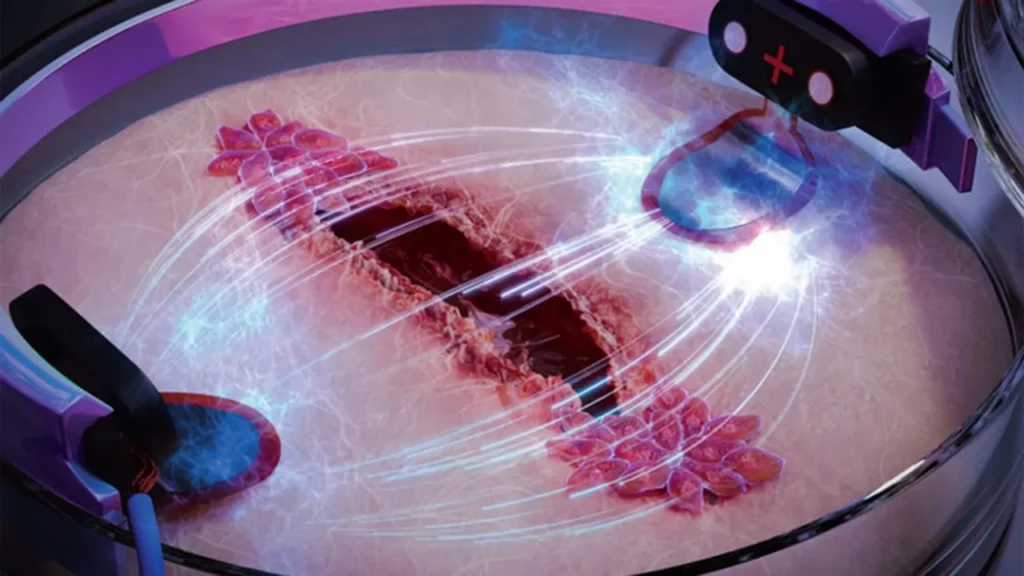
For many, a small wound may not pose any serious threat, but for people with diabetes, spinal injuries, or poor blood circulation, wound healing can be a major concern. Impaired wound healing leads to a greater risk of infection and chronic wounds that may even result in amputation in some extreme cases.
However, researchers at the Chalmers University of Technology and the University of Freiburg have recently developed a revolutionary method for speeding up the wound healing process through electric stimulation.
The results suggest that wound healing could be sped up by a staggering three-fold simply by applying a small, harmless electric field to the site of injury.
Maria Asplund, Associate Professor of Bioelectronics at Chalmers University of Technology and head of research on the project, explains, “Chronic wounds are a huge societal problem that we don’t hear a lot about. Our discovery of a method that may heal wounds up to three times faster can be a game changer for diabetic and elderly people, among others, who often suffer greatly from wounds that won’t heal.”
Guiding Cells with Electric Fields
Scientists have suspected for some time that the electric stimulation of damaged skin could promote the underlying tissue to heal wounds more quickly. That’s because skin cells are electrotactic, meaning they directionally “migrate” in electric fields.
Previous experiments showed that simply by placing an electric field in a petri dish with skin cells, the cells move directionally instead of randomly. But how could this principle be used to guide the cells electrically and make wounds heal faster?
The researchers used a tiny engineered chip to compare wound healing in artificial skin composed of cells called keratinocytes, which are the most common skin cell type and play a fundamental role in the healing process.
When the team compared the artificial skin subjected to electrical stimulation to samples that weren’t, the differences were staggering. The electrically stimulated wound healed three times faster than the one that healed without electric stimulation.
“We were able to show that the old hypothesis about electric stimulation can be used to make wounds heal significantly faster. In order to study exactly how this works for wounds, we developed a kind of biochip on which we cultured skin cells, which we then made tiny wounds in. Then we stimulated one wound with an electric field, which clearly led to it healing three times as fast as the wound that healed without electric stimulation,” Asplund says.
Hope for Diabetic Patients
The researchers focused on wound healing in connection with diabetes, which is a growing health problem worldwide. According to the World Health Organization (WHO) and the International Diabetes Federation, one in 11 adults has some form of diabetes.
“We saw that when we mimic diabetes in the cells, the wounds on the chip heal very slowly. However, with electric stimulation, we can increase the speed of healing so that the diabetes-affected cells almost correspond to healthy skin cells,” says Asplund.
The new findings open up the possibility for the generation of novel wound healing treatments that could benefit individuals with diabetes, spinal injuries, or poor blood circulation. In particular, the new method may dramatically help reduce the number of amputations caused by chronic wounds. According to the World Health Organization, up to 85% of amputations are caused by complications from slow-healing wounds in individuals with diabetes.
However, the strength of electrostimulation therapy lies in its customization to each patient’s individual needs. Asplund and her colleagues are currently investigating how different skin cells interact during stimulation to take a step closer to a realistic wound. The aim is to develop a system that ‘scans’ wounds and adapts the stimulation based on the individual wound.
The Chalmers researchers recently received a large grant which will allow them to continue their research in the field, and in the long run, enable the development of wound healing products for consumers on the market. Similar products have come out before, but more basic research is required to develop effective products that generate enough electric field strength and stimulate in the right way for each individual.
Their work opens the possibility for the development of new wound-healing products that could benefit millions of people suffering from slow-healing wounds. While more research is needed, this breakthrough gives hope for a future where chronic wounds are no longer a major health problem.
The findings appeared in the journal Lab on a Chip.


